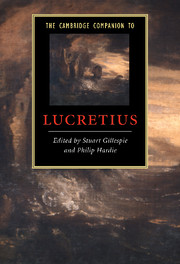Book contents
- Frontmatter
- Introduction
- Part I: Antiquity
- 1 Lucretius and Greek philosophy
- 2 Lucretius and the Herculaneum library
- 3 Lucretius and Roman politics and history
- 4 Lucretius and previous poetic traditions
- 5 Lucretian architecture: the structure and argument of the De rerum natura
- 6 Lucretian texture: style, metre and rhetoric in the De rerum natura
- 7 Lucretius and later Latin literature in antiquity
- Part II: Themes
- Part III: Reception
- Dateline
- List of works cited
- Index of Main Lucretian Passages Discussed
- General Index
5 - Lucretian architecture: the structure and argument of the De rerum natura
from Part I: - Antiquity
Published online by Cambridge University Press: 28 May 2010
- Frontmatter
- Introduction
- Part I: Antiquity
- 1 Lucretius and Greek philosophy
- 2 Lucretius and the Herculaneum library
- 3 Lucretius and Roman politics and history
- 4 Lucretius and previous poetic traditions
- 5 Lucretian architecture: the structure and argument of the De rerum natura
- 6 Lucretian texture: style, metre and rhetoric in the De rerum natura
- 7 Lucretius and later Latin literature in antiquity
- Part II: Themes
- Part III: Reception
- Dateline
- List of works cited
- Index of Main Lucretian Passages Discussed
- General Index
Summary
Introduction
From the arrangement of individual phrases to the grand structure of the entire poem, Lucretius uses poetic form with economy and imagination to attract the reader’s attention and to drive home his philosophical message. In their main lines, the structure and content of the poem’s argument derive from earlier Epicurean and other philosophical models, and Lucretius’ debts to some of his predecessors are quite detailed. But his handling of this material is distinctive, and his greatest originality lies in the reshaping of a philosophical exposition adapted from previous writers to produce a poem whose form instantiates the main points of its argument at every level and is aesthetically satisfying as well.
The order of argument and the question of Lucretius’ source
A long-standing question is: to what extent was Lucretius an original thinker as opposed to a versifier of received wisdom? For the purposes of this chapter, that question reduces to a related one: to what extent is the structure of the DRN Lucretius’ own design as opposed to something borrowed from a previous work? The first scholars to address this issue simply assumed that Lucretius closely followed some particular source. At length scholars started to leave this question aside, and the assumption that Lucretius worked without a single primary model in mind gained some appeal. More recently, the Herculaneum papyri have provided enough evidence to reopen the question.
Information
- Type
- Chapter
- Information
- The Cambridge Companion to Lucretius , pp. 76 - 91Publisher: Cambridge University PressPrint publication year: 2007
Accessibility standard: Unknown
Why this information is here
This section outlines the accessibility features of this content - including support for screen readers, full keyboard navigation and high-contrast display options. This may not be relevant for you.Accessibility Information
- 11
- Cited by
